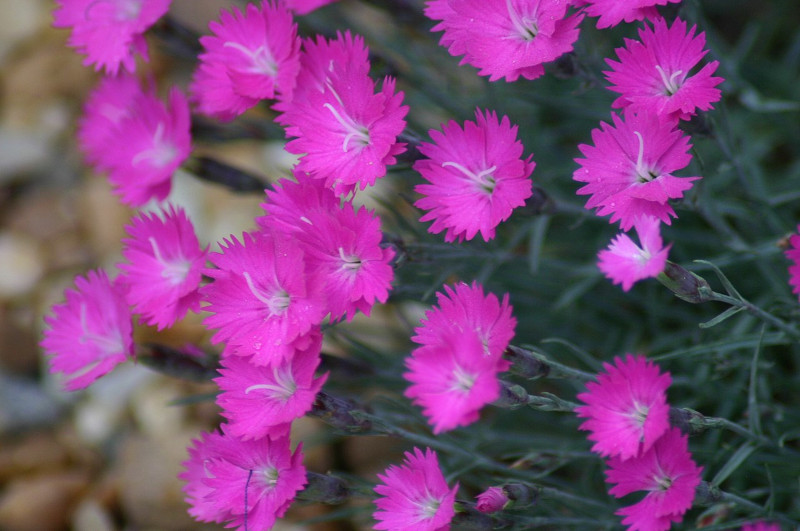
Cheddar Pink Facts
- This beautiful creation of Nature and evolution most frequently goes by the descriptive common name of the Cheddar Pink. The lovely plant does have at least one other general title that it’s known by, though. That’s the equally simple yet appropriate term of clove pink.
- Within scientific circles, however, the wonderful flora possibly remains much better known by its technical name. That, though, is a rather difficult term for the layperson to pronounce. That’s due to the fact that it bears the official moniker of Dianthus gratianopolitanus.
- The respected British botanist, Samuel Brewer holds the distinction of being the first person to officially recognize it as a separate and distinct species. The exact date of that is unknown, however. The english naturalist, John Ray, recorded the recognition in the year 1724.
- Fortunately, the Cheddar Pink seems to be maintaining a population base that’s both stable and sufficient. That status further appears to hold true throughout the entirety of its native range. The IUCN, thus, currently does not place it on its Red List of Threatened Species.
- The gorgeous flora nevertheless faces some potential threats to its continued existence as a species, at least. These consist of several factors, most of which stem from the actions of humans. They include such related perils as habitat loss and ongoing climate change.
Related Articles
Cheddar Pink Physical Description
The remarkable Cheddar Pink easily captivates and enthralls those who encounter it. Yet, it’s an excellent example of how Nature places no importance on size. That’s because this true marvel of botanical beauty constitutes a relatively small variety in terms of its sheer physical stature.
This beautiful perennial also develops as a ground-hugging charmer. Given that fact, individual examples of the plant rarely exceed 6 in (15 cm) vertically. Most, in fact, do not reach that height. It spreads out more, reaching a maximum measured width of approximately 12 in (30 cm).
The impressive herbaceous species also develops as evergreen in nature. Typically, its numerous thin stalks produce copious quantities of foliage. These highly elongated leaves usually appear in a generally mound-shaped structure. Each also typically presents a lovely grass-green shade.
It’s unquestionably the stunning flowers of the Cheddar Pink, though, that garner the most attention. Much like the plant they spring from, however, these do not do so due to their size. That’s because each of these gorgeous blooms attains an average width of only about 1 in (2.5 cm).
These the marvel of Nature and evolution produces in great abundance, though. Each appears at the top of a thin, wiry stem. Its petals generally present a fringed appearance, as well. But it’s their colors that catch the eye. These strongly fragrant blooms range from light pink to rose in color.
- Kingdom: Plantae
- Phylum: Tracheophytes
- Class: Eudicots
- Order: Caryophyllales
- Family: Caryophyllaceae
- Genus: Dianthus
- Species: D. gratianopolitanus
Cheddar Pink Distribution, Habitat, and Ecology
The magnificent Cheddar Pink evolved as endemic to a moderately broad swathe of the surface of the globe. Its exact range of habitation coincides with many other botanical wonders. That’s true since it evolved as native to a portion of what’s now known as the continent of Europe.
Within that greater area, however, it’s limited to only an extremely specific portion, natively. Its original territory extended from France to southern England. From there, it’s range extended as far as Poland. It’s additionally unknown if it ever appeared beyond this current habitat zone.
Now, though, it presently lives in only one known place on the entire planet, naturally. That’s the wonderful formation known as Cheddar Gorge, thus the name. Inside of this location, however, it exhibits very specific habitat requirements that further restrict its potential for spreading.
Inside of its present location, the captivating plant only lives on steep cliffs. These structures also happen to also be of limestone nature. This site shares a few attributes with other places it once appeared. The species requires a combination of full sun, medium water, and good drainage.
The mesmerizing Cheddar Pink most commonly blooms from the months of early May to late June. Its principal pollinators seem to consist of a variety of locally prevalent butterfly and bee species. Some specimens also display a tendency to bloom two separate times during this cycle.
Despite its seemingly fragile nature, evolution provided it with a highly efficient means of defense. Few if any grazing animals, such as deer, feed on this wonder. That’s because it contains quantities of chemicals that render it toxic to many creatures. That list includes horses, dogs, cats, and deer.
Species Sharing Its Range
Check out our other articles on 5 Beautiful North American Birds, Striped Skunk, Great Barrier Reef, Southern Plains Bumblebee, Scalloped Hammerhead, Knysna Seahorse, Green Iguana
